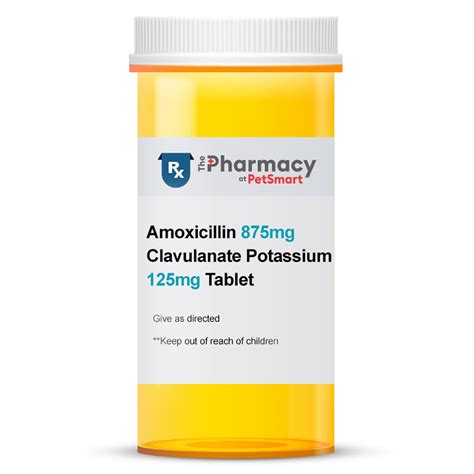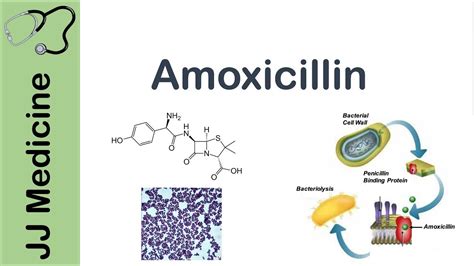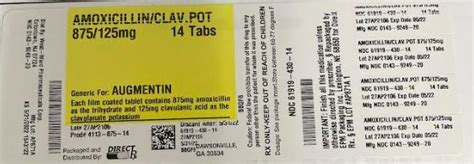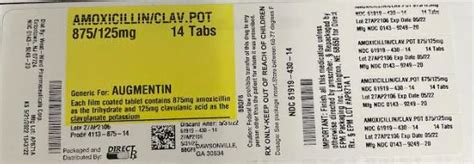Intro
Discover key facts about Amoxicillin Clav 875 125, including its uses, dosage, and side effects, to understand this antibiotics role in treating bacterial infections, respiratory issues, and more, with insights into its composition, interactions, and benefits.
The importance of understanding antibiotics cannot be overstated, especially when it comes to medications like Amoxicillin Clav 875 125. This antibiotic is a combination of two active ingredients: amoxicillin and clavulanic acid. It's widely prescribed for various bacterial infections, offering a broad spectrum of activity against both Gram-positive and Gram-negative bacteria. As we delve into the specifics of Amoxicillin Clav 875 125, it's crucial to grasp its benefits, potential side effects, and the proper way to use it to ensure effective treatment and minimize resistance.
Amoxicillin Clav 875 125 is designed to combat bacterial infections by inhibiting the growth of bacteria. Amoxicillin works by interfering with the formation of the bacterial cell wall, leading to the death of the bacteria. However, many bacteria have developed resistance to amoxicillin by producing an enzyme called beta-lactamase, which breaks down amoxicillin and renders it ineffective. This is where clavulanic acid comes into play. Clavulanic acid inhibits the action of beta-lactamase, thereby protecting amoxicillin from degradation and allowing it to effectively kill the bacteria.
The combination of amoxicillin and clavulanic acid in Amoxicillin Clav 875 125 makes it a potent tool against a wide range of infections, including respiratory tract infections, skin and soft tissue infections, and urinary tract infections. Its effectiveness has made it a commonly prescribed antibiotic, but like all medications, it must be used responsibly and under the guidance of a healthcare professional to ensure safety and efficacy.
Introduction to Amoxicillin Clav 875 125

Amoxicillin Clav 875 125 is typically administered orally, with the dosage and duration of treatment depending on the type and severity of the infection being treated. It's essential to complete the full course of treatment as prescribed, even if symptoms improve before finishing the medication, to ensure that the infection is fully cleared and to reduce the risk of antibiotic resistance.
Benefits of Amoxicillin Clav 875 125
The benefits of Amoxicillin Clav 875 125 include its broad-spectrum activity, which makes it effective against a wide range of bacterial infections. It is also generally well-tolerated, with common side effects being mild and temporary. Additionally, the combination of amoxicillin and clavulanic acid provides a synergistic effect, enhancing the antibiotic's efficacy against bacteria that might be resistant to amoxicillin alone.How Amoxicillin Clav 875 125 Works

The mechanism of action of Amoxicillin Clav 875 125 involves the inhibition of cell wall synthesis in bacteria. Amoxicillin binds to and inhibits penicillin-binding proteins (PBPs) located inside the bacterial cell wall, resulting in the weakening of the bacterial cell wall and ultimately leading to cell lysis and death. Clavulanic acid, on the other hand, protects amoxicillin from degradation by beta-lactamase enzymes, thereby extending the spectrum of activity of amoxicillin to include beta-lactamase-producing strains of bacteria.
Steps for Taking Amoxicillin Clav 875 125
To take Amoxicillin Clav 875 125 effectively: - Take the medication exactly as prescribed by your healthcare provider. - Complete the full course of treatment, even if you start feeling better before finishing the medication. - Take the medication at the same time each day to maintain a consistent level of the medication in your system. - It's recommended to take Amoxicillin Clav 875 125 with food to reduce the risk of gastrointestinal side effects.Side Effects and Precautions

While Amoxicillin Clav 875 125 is generally well-tolerated, it can cause side effects, including but not limited to:
- Diarrhea
- Nausea
- Vomiting
- Rash
- Yeast infections
It's essential to discuss any concerns or pre-existing conditions with your healthcare provider before starting treatment. Certain conditions, such as a history of allergic reactions to penicillins or cephalosporins, may require caution or alternative treatments.
Interactions with Other Medications
Amoxicillin Clav 875 125 can interact with other medications, including: - Blood thinners, which may increase the risk of bleeding - Methotrexate, which may increase the risk of side effects - Probenecid, which may decrease the excretion of amoxicillin, potentially leading to increased levels and effectsPractical Examples and Statistical Data

Studies have shown that Amoxicillin Clav 875 125 is effective in treating a variety of bacterial infections. For instance, in the treatment of community-acquired pneumonia, Amoxicillin Clav 875 125 has been shown to have a high success rate, with clinical cure rates often exceeding 85%. Similarly, in the treatment of skin and soft tissue infections, Amoxicillin Clav 875 125 has demonstrated efficacy against a broad range of pathogens, including Staphylococcus aureus and Streptococcus pyogenes.
Conclusion and Future Directions
In conclusion, Amoxicillin Clav 875 125 is a valuable antibiotic in the treatment of bacterial infections. Its broad-spectrum activity, combined with its generally favorable safety profile, makes it a commonly prescribed medication. However, as with all antibiotics, the use of Amoxicillin Clav 875 125 must be judicious and guided by principles of antimicrobial stewardship to combat the growing problem of antibiotic resistance.Final Thoughts

As we look to the future, the development of new antibiotics and the responsible use of existing ones, like Amoxicillin Clav 875 125, are critical in the fight against bacterial infections. By understanding the benefits, mechanisms, and potential side effects of Amoxicillin Clav 875 125, healthcare providers and patients can work together to ensure effective treatment and minimize the risk of antibiotic resistance.
We invite you to share your thoughts and experiences with Amoxicillin Clav 875 125 in the comments below. Your input can help others understand the medication better and foster a community of informed individuals working together to promote responsible antibiotic use.
What is Amoxicillin Clav 875 125 used for?
+Amoxicillin Clav 875 125 is used to treat a wide range of bacterial infections, including respiratory tract infections, skin and soft tissue infections, and urinary tract infections.
How does Amoxicillin Clav 875 125 work?
+Amoxicillin Clav 875 125 works by inhibiting the growth of bacteria through the action of amoxicillin, which is protected from degradation by beta-lactamase enzymes by clavulanic acid.
What are the common side effects of Amoxicillin Clav 875 125?
+Common side effects include diarrhea, nausea, vomiting, rash, and yeast infections. It's essential to discuss any concerns with your healthcare provider.
